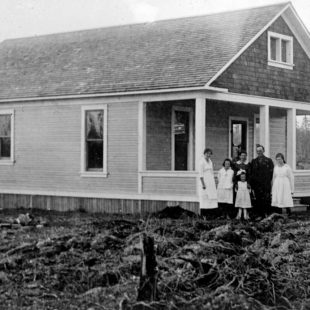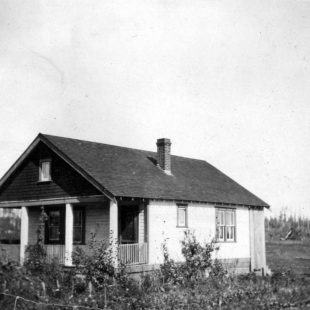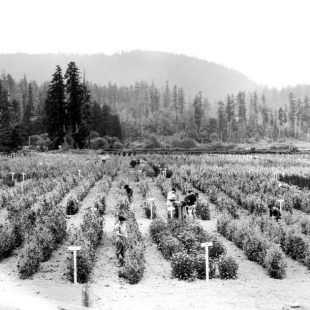“As there is pressing need for securing land for the settlement of returned soldiers under the provisions of the Soldier Settlement Act, the comparatively large areas of Indian reserve lands throughout the country, which were but scantily used by the Indians, were sought as a source of supply.” – Duncan Campbell Scott, Deputy Superintendent of the Department of Indian Affairs[1]

Following the end of the war, the government of Canada found themselves having to support thousands of veterans who were returning from their service overseas. The Department of Soldiers’ Civil Reestablishment was created in February of 1918 for just this purpose. Out of this department arose the Soldier Settlement Scheme, whose British Columbia office ran out of Victoria, which involved the allocation of crown land to returned soldiers who were aided in establishing farming and agricultural practices.[2] The land, however, that they were distributing included over 84, 000 acres nationally of reserve land which were sold by the Government of Canada to the board of the scheme. [3] This was made possible because of an amendment to the Indian Act in 1918 which eliminated the need for consent in order for reserve land to be taken. Furthermore, despite their service and apparent inclusion in the scheme, Indigenous soldiers were often allotted sub-par plots of land. Indigenous soldiers received smaller plots than their non-indigenous counterparts, which often came with low-quality soil, outdated equipment and inadequate livestock. Part of the scheme was to give loans to soldiers when they first started out on the land. Indigenous soldiers received on average $1894 each, while non-Indigenous soldiers received over $4000 on average. [4]
Vancouver Island
“Vancouver Island, B.C., affords some striking examples of what a resolute man may accomplish in a short time with the assistance he is able to secure from the Soldier Settlement Board. Owing to the restricted areas of cleared land, the farm holdings are small, and settlers for the most part engage in intensive farming, such as the production of small fruits, dairying and poultry raising from which ample returns are secured to meet their obligations.” – Report of the Soldier Settlement Board, 1921
Merville

The town of Merville, located in the Comox Valley on Vancouver Island, was a town entirely settled by returned soldiers. The Soldier Settlement Board purchased the burned and logged land from the Comox Logging Company.[5] In the early days of its existence, the town consisted of over 13, 660 acres and a soldier settlement population of 400. [6] The town itself was named by the soldiers after Merville, France, a village of significance to this batch of soldiers.
Extracts from Soldier Settlement Board Report on soldier settlers on Vancouver Island

“Instance the operations of Captain J. G. C. Wood, formerly of the First Canadian Pioneers, who settled on twenty-five acres near Keatings in December, 1910. He had ten acres broken, two acres of which he seeded to wheat, but the major portion of the cultivafed ground was taken up with the production of loganberries, raspberries and strawberries. The revenue from his small fruits in 1920 was in the neighbourhood of $6,000 and he had some returns as well from milk. His obligations to the board total $7,500. He purchased the place as a going concern and since being established he has finished the interior of his house, made extensive alterations- to his stable, installed a gravity water system with pipe connections in his house and barn and has sufficient water surplus to irrigate his cane fruits, if that should be required. He also has put in considerable tile drainage. It is the intention to clear about two acres of new land each year, thus giving the land time to go through a thorough hoe crop rotation before planting.”
“Another soldier settler who has realized handsome returns from the sale of eggs, poultry, milk and butter, aggregating d’urirfg the year $2,978, is R. S. A. Jackson, formerly of the 18th Field Ambulance. He is near the town of Duncans, where he has 15 acres of black and red loam, one-half of which is covered with light timber, chiefly fir. Hie loans total $7,000. Commencing operations in June, 1919, and specializing in poultry, he acquired 85 laying pullets with about 750 day-old chicks. 50 per cent of which were cockerels. He now has 400 pullets, 175 breeders and 30 cockerels. He also has 20 R. I. Red capons, which will weigh when fattened eight or nine pounds, and he has a standing offer for these at 65 cents a pound. He expects next year to go in more extensively for caponizing. Mr. Jackson entered a pen of White Leghorn chickens in the International Egg Laying Contest and received four diplomas of merit and a bronze medal, one of his birds laying the second highest number of eggs. He also entered a pen of White Leghorns in a Dominion Egg Laying Contest at Agassiz, leading when this report was written. He refitted all his old chicken houses, erected a new house to accommodate 250 birds, also a 1,000-chick brooder house and has cleared over an acre of ground. He also rented some land close by which he sowed to wheat, from which he harvested enough wheat for several months’ feed. This settler also has a fine Jersey grade cow which took first prize at Duncans. He expects to go in for poultry raising on a more ambitious scale the coming season. The sales record from September, 1919, to November 15, 1920, shows 3,0&6 dozen eggs sold for $1,975.24; bird sales aggregating $818, while he also had revenue from milk and butter amounting to $184.”[7]
[1] Department Of Indian Affairs. Annual Report of the Department of Indian Affairs for the Year Ended March 31 1919. 1 George V Sessional Paper No. 27 ed. Printed by Order of Parliament Ottawa, J. De Labroquerie Tache Printer to the King’s Most Excellent Majesty, 1920. Page 53.
[2] Fred Gaffen, Forgotten Soldiers. Penticton, B.C.: Theytus Books, 1985, 27
[3] Dempsey, L. James. Warriors of the King: Prairie Indians in World War I. Regina, Sask.: Canadian Plains Research Center, University of Regina, 1999. 77
[4] Story, Eric, The Awakening Has Come: Canadian First Nations in the Great War Era, 1914-1932. Canadian Military History, Vol 24, 2015, Iss 2, Art 2
[5] Koroscil, Paul M. 1982. Soldiers, settlement and development in british columbia, 1915-1930. BC Studies 54 : 63. 77
[6] Soldier Settlement on the Land: Report of the Soldier Settlement Board of Canada March 31 1921. F. A. Acl. Printer to the King’s Most Excellent Majesty, 1921.
[7] Ibid.
